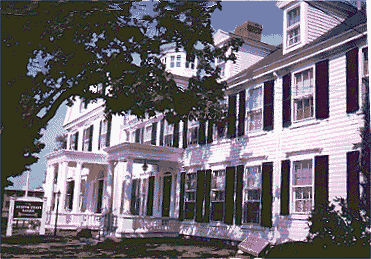The historic Governor Sprague Mansion is going to be throwing a party to celebrate the 100th Anniversary of the City of Cranston, RI. March 10, 2010 was the official anniversary date of Cranston becoming a city. We blogged about that back in March (which you can read here) and the ProJo mentioned Cranston planning a anniversary celebration in October. Located right on Cranston Street in Cranston (not far from the site of the original Narragansett Brewery), the Sprague Mansion is rich in historic events. Among those events being the birth of two RI Govenors and US Senators. So it's the perfect setting to host Cranston's 100th Anniversary party. Since the mansion has been there throughout the history of the city. They are holding a reception next Saturday, October 16. It's only $15 and you get plenty of food, drinks and great entertainment. Please call (401) 944-9226 for details and tickets. And visit CranstonHistoricalSociety.org for more. Here's the history of the mansion the Cranston Historical Society website.
The establishment of Cranston Print Works in 1808 which became the center of Cranston Village. Governor William Sprague the 3rd brought in the railroads to transport finished cloth from the Natick, Quidnick, and Arctic, and Baltic Mills of Sprague, CT for the Print Works to use. The workers of A & W Sprague Manufacturing lived in the mill houses and shopped at the mill stores. In 1843, Amasa Sprague was brutally murdered on the Pocasset River in Johnston. An Irish immigrant named John Gordon was wrongfully accused and executed for the murder. Which brought about the end of capital punishment in RI. This may also be why some believe the mansion to be haunted today. In fact, the local TAPS team investigated this haunting on an episode of the SyFy channel's hit show, Ghost Hunters. The Union Horsecar Railroad system brought Sprague printed goods to the Providence Docks and is seen as the grandfather of the Rhode Island Transit System today. Governor William Sprague the 4th supplied the Union Army with horses and fought in the front of the Battle Of Bull Run during the Civil War.
The Sprague Mansion was built in two parts, each representing in its own way, the prosperity of the Sprague Family which came to Cranston as early as 1712.
The small family homestead was constructed in the late 18th century. Featuring a central chimney, low ceilings, simple woodwork, it was a spacious type of home of the well-to-do farmer and merchant of the post-Revolutionary era.
Over the years there have been many changes to the Mansion but the most dominate changes were made in the 1864 by Col. Amasa Sprague when he upgraded the house from the simple homestead to an elegant home where he entertained his social contacts.The new addition included a wide hall lighted by a fan-shaped window above the entrance door.
Instead of the plain straight steep stairs of the old part of the house, the staircase in the 1860's part of the mansion is wide and winding. The woodwork of the balusters and railings is carved and decorative.
The mantles of the fireplaces in the new section of the house are also representative of the times, Italian marble graces the fireplace in the grand ball room on the first floor where the Sprague's would have entertained many visitors from the financial, political and sporting circles.
To compliment our ball room is a 1880 Steinway Centennial Concert Grand Piano. This nearly nine feet long piano was a gift of Shaw Safe Family of Newport and has a history. It was purchased in November of 1880 by William Gammell, a Brown Professor of Rhetoric and English Literature and History and Political Economy. Professor Gammell served as President of the Rhode Island Historical Society
Two large bedrooms on the second and third floors replaced the more numerous small bedrooms of the old part of the homestead. The rooms on the third floor on the old side of the mansion were small and many and used by William Sprague II to house many of the men who worked in nearby "Sprague's Woods" and at the Sprague Print Works during the 1830's.
The most striking feature of the mansion at first glance is the cupola high atop the new section of the mansion. From here the Sprague's viewed their panorama of Cranston holdings, the orchards; vineyards; woodlands; reservoir; a railroad; a horsecar company; the Cranston Print Works Manufacturing Company and its two villages of mill houses, complete with a school, community store; boarding houses, meeting house, post office, and counting house, sometimes called the Cranston Bank and a horse racing track. They were Masters of all they surveyed.
By Gladys M. Brayton 1966 with updating by Lydia Rapoza 2000
The Mansion has been well maintained in its original condition down through the years. Modern facilities have since been tastefully added making the building suitable for the use of large groups when required. Now restored to much of its elegance and splendor the Mansion is once again used for cultural and civic activities. Furnished throughout by gifts and items on loan, the Mansion holds items that belonged to the Sprague family.
The lovely carriage house was built in 1864 and retains much of the charm and character it would have had when it housed the mill teams of the A. & W. Sprague Company.




